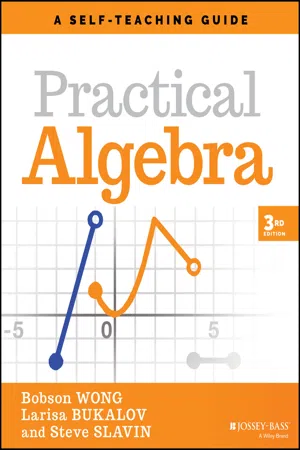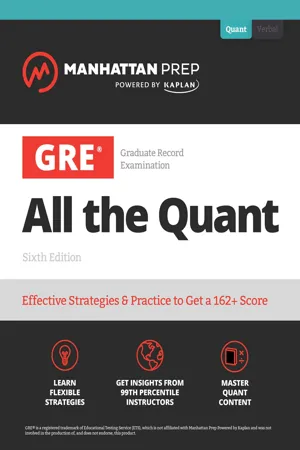Mathematics
Inequalities Maths
In mathematics, inequalities refer to mathematical expressions that compare two quantities and indicate their relative sizes. These expressions use symbols such as < (less than), > (greater than), ≤ (less than or equal to), and ≥ (greater than or equal to). Inequalities are used to represent relationships between numbers and are fundamental in solving equations and making comparisons.
Written by Perlego with AI-assistance
Related key terms
1 of 5
6 Key excerpts on "Inequalities Maths"
- eBook - PDF
Practical Algebra
A Self-Teaching Guide
- Bobson Wong, Larisa Bukalov, Steve Slavin(Authors)
- 2022(Publication Date)
- Jossey-Bass(Publisher)
5 LINEAR INEQUALITIES So far, we’ve worked extensively with equations. However, we often deal with situa-tions where we find values of the variable in which one expression is greater than or less than another. Fortunately, despite some important differences, the methods we use here are similar to the methods we used to solve equations. 5.1 Basic Principles of Solving Inequalities First, let’s start with a basic definition: an inequality is a statement that says that one expression is greater than or less than another expression. Like equations, inequalities must be either true or false—they can’t be both at the same time. As with equations, we often want to find the values of the variables that make the inequality true. We call these the solutions to the inequality . In Chapter 1, we used number lines to represent positive and negative numbers. Recall that positive numbers appear to the right of 0, and negative numbers appear to the left of 0. Also, any number that appears to the right of another is the greater number. We use the following inequality symbols: • > (pronounced “is greater than”) • ≥ (pronounced “is greater than or equal to,” combines the > and = symbols) • < (pronounced “is less than”) • ≤ (pronounced “is less than or equal to,” combines the < and = symbols) Here are some important points about the direction of inequalities: • The inequality symbols in statements like 6 > 2 and 5 > 3 have the same direction. • The inequality symbols in statements like 6 > 2 and 4 < 5 have the opposite direction. • If we reverse the order of the numbers, then we reverse the direction of the inequality symbol, so 3 > 1 is equivalent to 1 < 3. 111 112 PRACTICAL ALGEBRA Reading and Writing Tip The > and < symbols are easily confused. Figure 5.1 can help you remember that the inequal-ity symbols “open” in the direction of the larger number: 5 3 Figure 5.1 5 is greater than 3. Example 5.1 Determine if the inequality + 1 > − 2 is true. - Available until 12 Jan |Learn more
GRE All the Quant
Effective Strategies & Practice from 99th Percentile Instructors
- (Author)
- 2023(Publication Date)
- Manhattan Prep(Publisher)
CHAPTER 7 Inequalities and Systems of Equations Now that you’re more familiar with exponents and substitution, it’s time to tackle inequalities and more advanced equations.Inequalities behave similarly to equations in most ways, but with a few important distinctions. What is written on one side of the inequality has a relationship to what is on the other side, but the two sides are not defined as strictly equal. For example:3x − 5 ≤ 6x − 11The left side, 3x − 5, is less than or equal to the right side, 6x − 11. In this chapter, you’ll learn how to manipulate and solve this and more complicated inequalities, as well as how to solve when you are given an inequality alongside an absolute value equation, a regular equation, or a second inequality.Interpreting Inequalities
Inequalities are expressions that use <, >, ≤, or ≥ to describe the relationship between two values. Each of these signs has a distinct meaning:
Translating inequalities correctly is essential. Read them from left to right:< Less than > Greater than ≤ Less than or equal to (or at most) ≥ Greater than or equal to (or at least) Read as... or... 5 > 4 5 is greater than 4. y ≤ 7 y is less than or equal to 7. y is at most 7. x < 5 x is less than 5. 2x + 3 ≥ 0 2x + 3 is greater than or equal to 0. 2x + 3 is at least 0. You can also have two inequalities in one statement (sometimes called a compound inequality):Read as... 9 < f < 200 9 is less than f, and f is less than 200. Alternatively, f is between 9 and 200. −3 < y ≤ 5 −3 is less than y, and y is less than or equal to 5. 7 ≥ x ≥ 2 7 is greater than or equal to x, and x is greater than or equal to 2. Alternatively, x is between 2 and 7, inclusive. Why does the last example use the word inclusive in the alternative reading? And why does the middle example not have an alternative form at all?Mathematically, the word inclusive means including. If x is between 2 and 7 inclusive, then 2 and 7 are included in that range; that is, x can be 2 and x can be 7. Contrast that with: f is between 9 and 200. In this case, f must be between those two values but f - eBook - PDF
Beginning Algebra
Connecting Concepts through Applications
- Mark Clark, Cynthia Anfinson(Authors)
- 2018(Publication Date)
- Cengage Learning EMEA(Publisher)
So far in this section, we have worked all the examples using inequalities. Interval notation and number lines are also used to represent the solution set of an inequality. The inequality x , 5 can be represented in any of the following three ways. In Words Mathematical Representation As an inequality x , 5 Using interval notation 1 2` , 5 2 Graphed on a number line ] 1 ] 2 ] 3 ] 4 ] 5 ] 6 ] 7 ] 8 ] 9 ] 10 0 1 2 3 4 5 6 7 8 9 10 In interval notation, use either parentheses ( ) or brackets [ ] to indicate the ends of the interval. Parentheses are used when the end point is not included in the interval. When either a less than symbol or a greater than symbol is used in the inequality, parentheses are used in writing the solution set as an interval. If the end point is included in the interval, then a bracket is used. This happens when an “equal to” part is included with the inequality, such as “greater than or equal to.” The infinity symbol, ` , is used to indicate that the interval does not stop in that direction and gets increasingly larger. Many intervals in this book will continue either to positive infinity or to negative infinity. Always use a parenthesis next to an infinity symbol. As an example, the inequality x . 2 1 is written as 1 2 1, ` 2 . Remember that we always write intervals starting with the left end point and ending with the right end point. [left end point, right end point] Number lines also use parentheses or brackets to indicate whether an end point of an interval is included or not. If an end point is not included, a parenthesis is used. If the end point is included in the interval, then a bracket is used. Some math instructors and textbooks will use open dots and closed dots with number lines instead of parentheses and brackets. If an interval goes to ` or 2` , an arrowhead is used to indicate the line goes on forever. Following are some examples of the three types of notation being used. - eBook - PDF
Sources in the Development of Mathematics
Series and Products from the Fifteenth to the Twenty-first Century
- Ranjan Roy(Author)
- 2011(Publication Date)
- Cambridge University Press(Publisher)
6 Inequalities 6.1 Preliminary Remarks In his 1928 presidential address to the London Mathematical Society, G. H. Hardy observed, “A thorough mastery of elementary inequalities is to-day one of the first necessary qualifications for research in the theory of functions.” He also recalled, “I think that it was Harald Bohr who remarked to me that that ‘all analysts spend half their time hunting through the literature for inequalities which they want to use and cannot prove.’ ” It is surprising, however, that the history of one of our most basic inequalities, the arithmetic and geometric means inequality (AMGM), is tied up with the theory of algebraic equations. Inequalities connected with the symmetric functions of the roots of an equation were used to determine the number of that equation’s positive and negative roots. In 1665–66, Newton laid down the foundation in this area when, in order to determine the bounds on the number of positive and negative roots of equations, he stated a far-reaching generalization of Descartes’s rule of signs. The arithmetic and geometric means inequality states that if there are n nonnega- tive numbers a 1 ,a 2 ,...,a n and there are n positive numbers q 1 ,q 2 ,...,q n , such that ∑ n i =1 q i = 1, then a q 1 1 a q 2 2 ··· a q n n ≤ n i =1 q i a i , (6.1) where equality holds only when all the a i are equal. The theory of equations has an interesting connection with the case for which q i = 1/n: (a 1 a 2 ··· a n ) 1/n ≤ n i =1 a i /n. (6.2) Note that when n = 2, the AMGM is simply another form of (a 1 − a 2 ) 2 ≥ 0; (6.3) this case can probably be attributed to Euclid. The nature of the relationship between the AMGM and algebraic equations is clear from (6.2). To see this, suppose that 81 82 Inequalities a 1 ,a 2 ,...,a n are the roots of x n − A 1 x n−1 + A 2 x n−2 + ··· + (−1) n A n = 0. Then (6.2) is identical with the inequality A 1/n n ≤ A 1 . - Ranjan Roy(Author)
- 2021(Publication Date)
- Cambridge University Press(Publisher)
6 Inequalities 6.1 Preliminary Remarks In his 1928 presidential address to the London Mathematical Society, 1 G. H. Hardy observed, “A thorough mastery of elementary inequalities is to-day one of the first necessary qualifications for research in the theory of functions.” He also recalled, “I think that it was Harald Bohr who remarked to me that ‘all analysts spend half their time hunting through the literature for inequalities which they want to use and cannot prove.’ ” It is surprising, however, that the history of one of the most basic inequalities, the arithmetic and geometric means inequality (AMGM), is tied up with the theory of algebraic equations. Inequalities connected with the symmetric functions of the roots of an equation were used to determine the number of that equation’s positive and negative roots. In 1665–1666, Newton laid down the foundation in this area when, in order to determine the bounds on the number of positive and negative roots of equations, he stated a far-reaching generalization of Descartes’s rule of signs. The arithmetic and geometric means inequality states that if there are n nonnegative numbers a 1 ,a 2 , . . . ,a n and there are n positive numbers q 1 ,q 2 , . . . ,q n , such that ∑ n i =1 q i = 1, then a q 1 1 a q 2 2 · · · a q n n ≤ n i =1 q i a i , (6.1) where equality holds only when all the a i are equal. The theory of equations has an interesting connection with the case for which q i = 1 n : (a 1 a 2 · · · a n ) 1 n ≤ n i =1 a i n . (6.2) 1 Hardy (1929). 116 6.1 Preliminary Remarks 117 Note that when n = 2, the AMGM is simply another form of (a 1 − a 2 ) 2 ≥ 0; (6.3) this case can probably be attributed to Euclid. The nature of the relationship between the AMGM and algebraic equations is clear from (6.2). To see this, suppose that a 1 ,a 2 , . . . ,a n are the roots of x n − A 1 x n−1 + A 2 x n−2 + · · · + (−1) n A n = 0. Then (6.2) is identical with the inequality A 1 n n ≤ A 1 n .- eBook - PDF
- Ron Larson(Author)
- 2021(Publication Date)
- Cengage Learning EMEA(Publisher)
eChapter(s). Editorial review has deemed that any suppressed content does not materially affect the overall learning experience. Cengage Learning reserves the right to remove additional content at any time if subsequent rights restrictions require it. 144 Chapter 1 Equations, Inequalities, and Mathematical Modeling GO DIGITAL Rational Inequalities The concepts of key numbers and test intervals can be extended to rational inequalities. Use the fact that the value of a rational expression can change sign at its zeros (the x-values for which its numerator is zero) and at its undefined values (the x-values for which its denominator is zero). These two types of numbers make up the key numbers of a rational inequality. When solving a rational inequality, begin by writing the inequality in general form, that is, with zero on the right side of the inequality. EXAMPLE 5 Solving a Rational Inequality Solve 2x - 7 x - 5 ≤ 3. Then graph the solution set. Solution 2x - 7 x - 5 ≤ 3 Write original inequality. 2x - 7 x - 5 - 3 ≤ 0 Write in general form. 2x - 7 - 3x + 15 x - 5 ≤ 0 Find the LCD and subtract fractions. -x + 8 x - 5 ≤ 0 Simplify. Key numbers: x = 5, x = 8 Zeros and undefined values of rational expression Test intervals: (- ∞ , 5), (5, 8), (8, ∞ ) Test: Is -x + 8 x - 5 ≤ 0? Testing these intervals, as shown in the figure below, the inequality is satisfied on the open intervals (- ∞ , 5) and (8, ∞ ).
Index pages curate the most relevant extracts from our library of academic textbooks. They’ve been created using an in-house natural language model (NLM), each adding context and meaning to key research topics.





